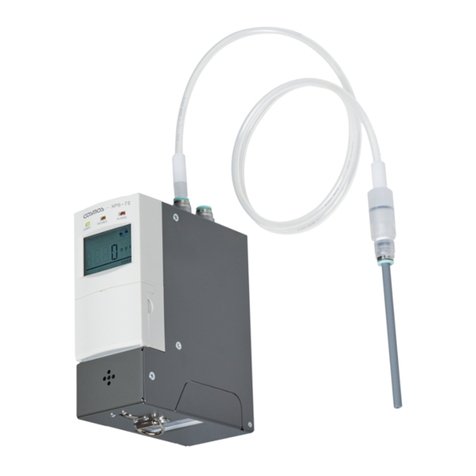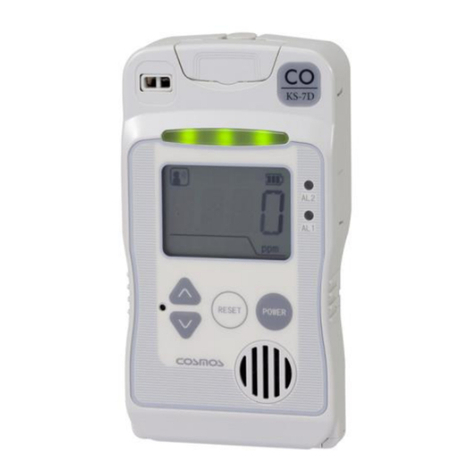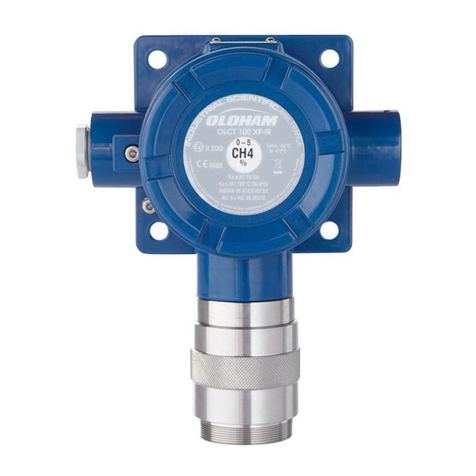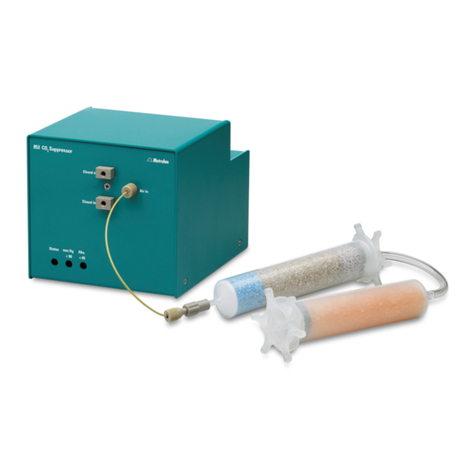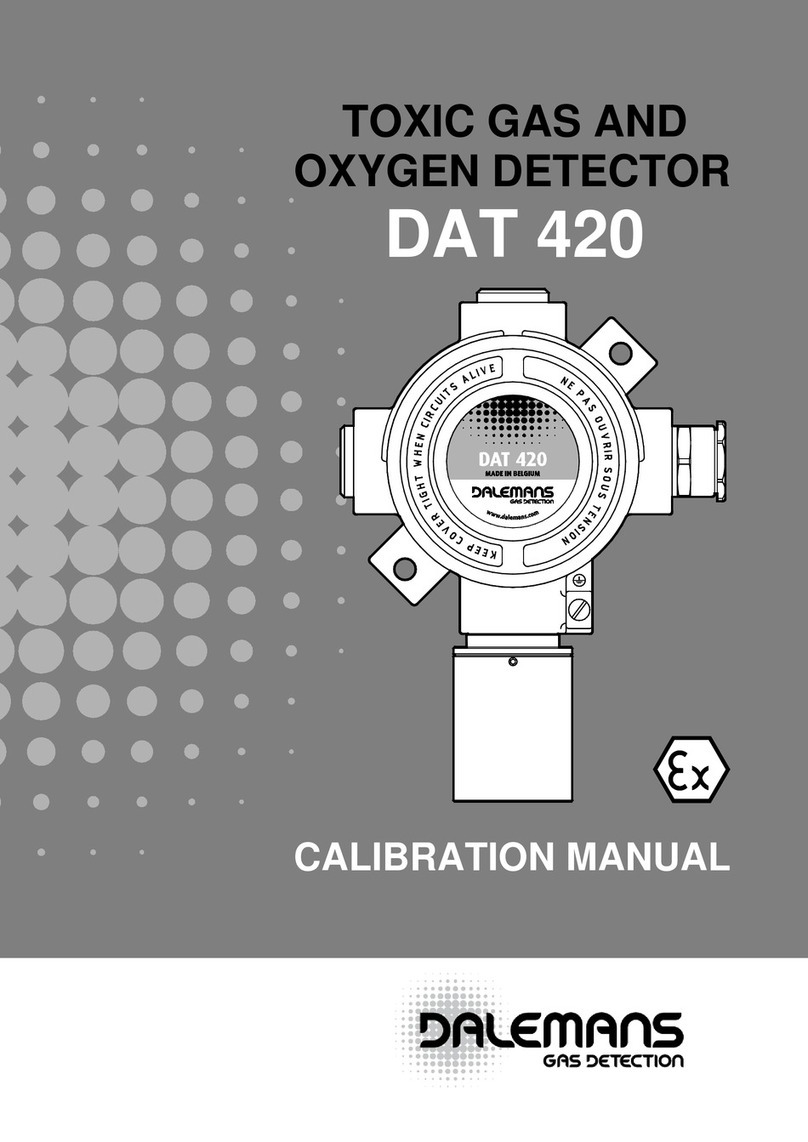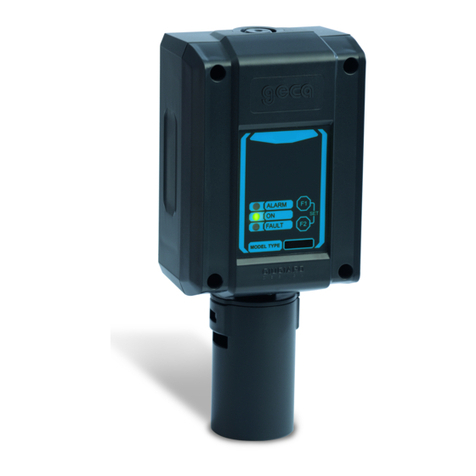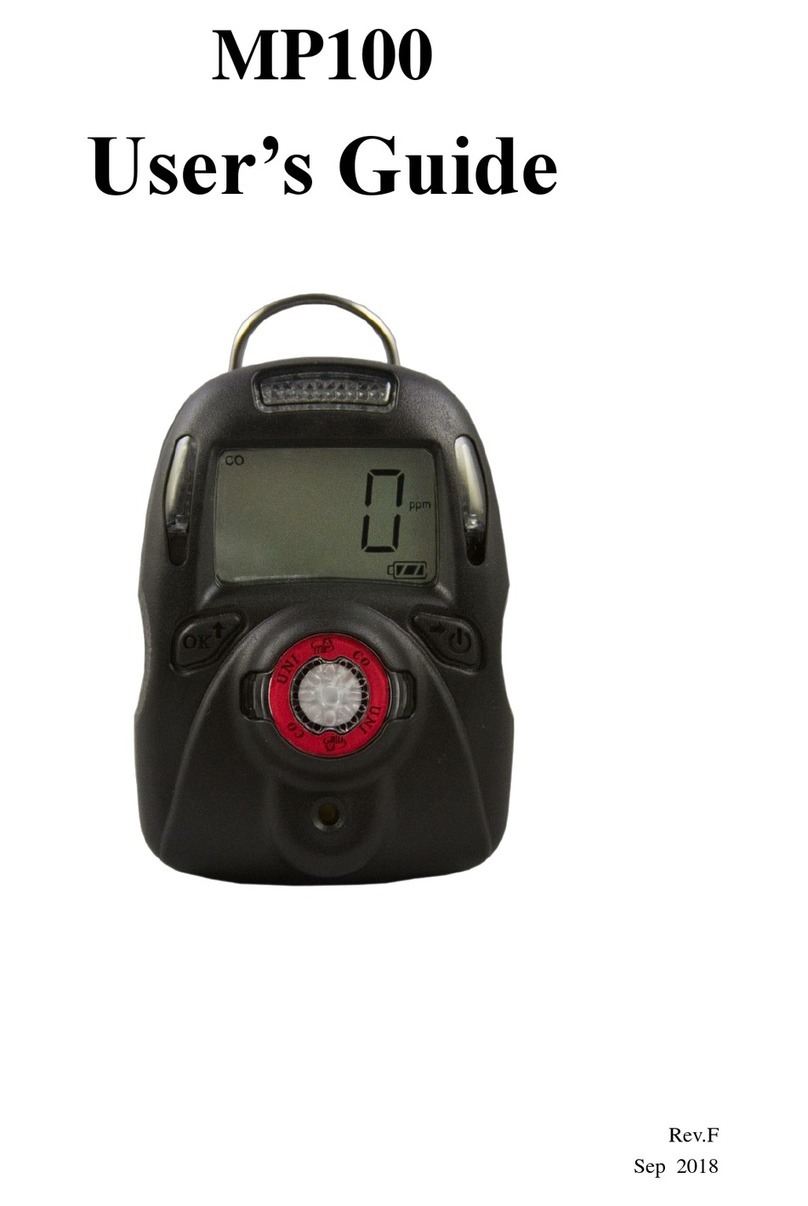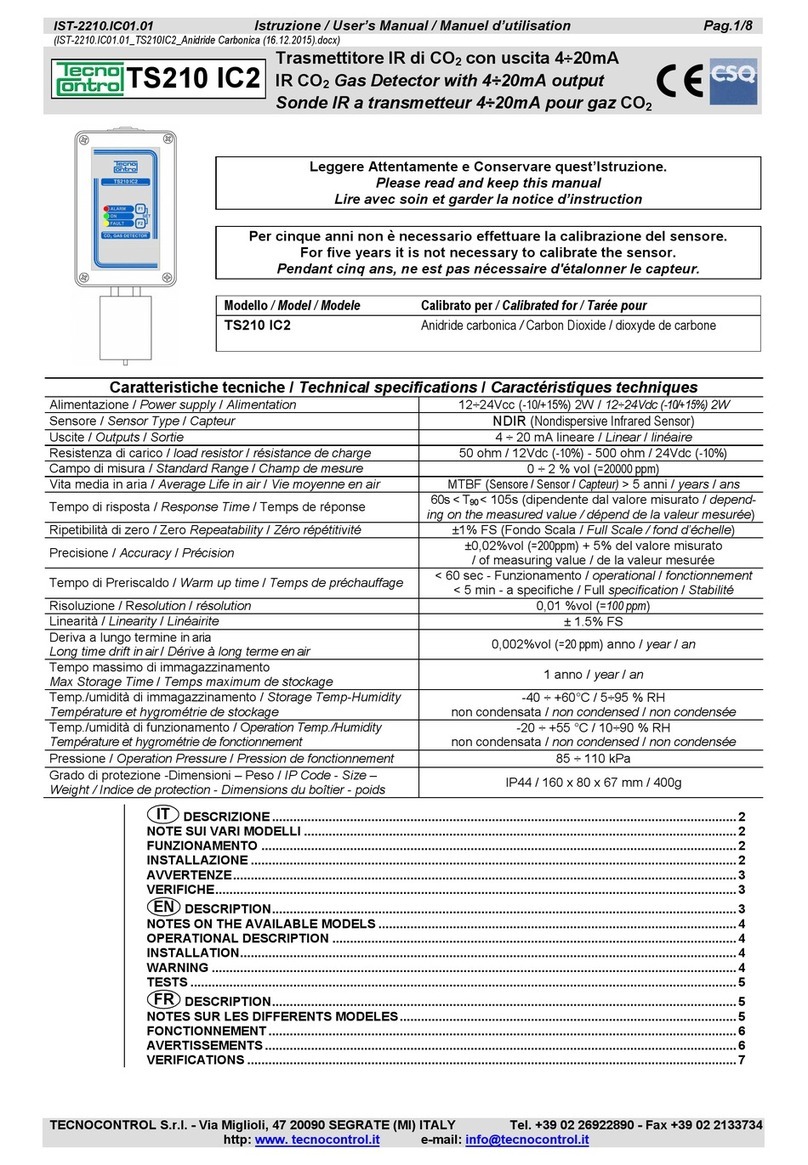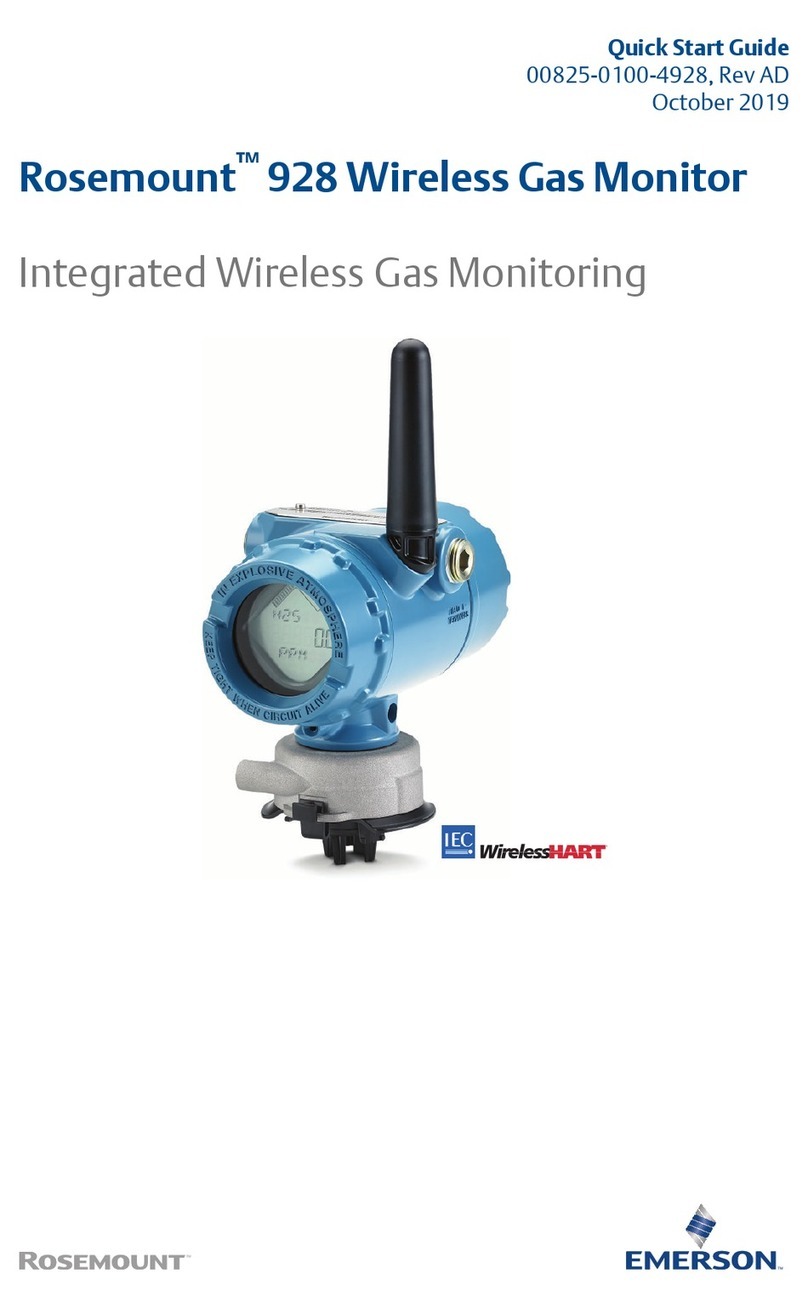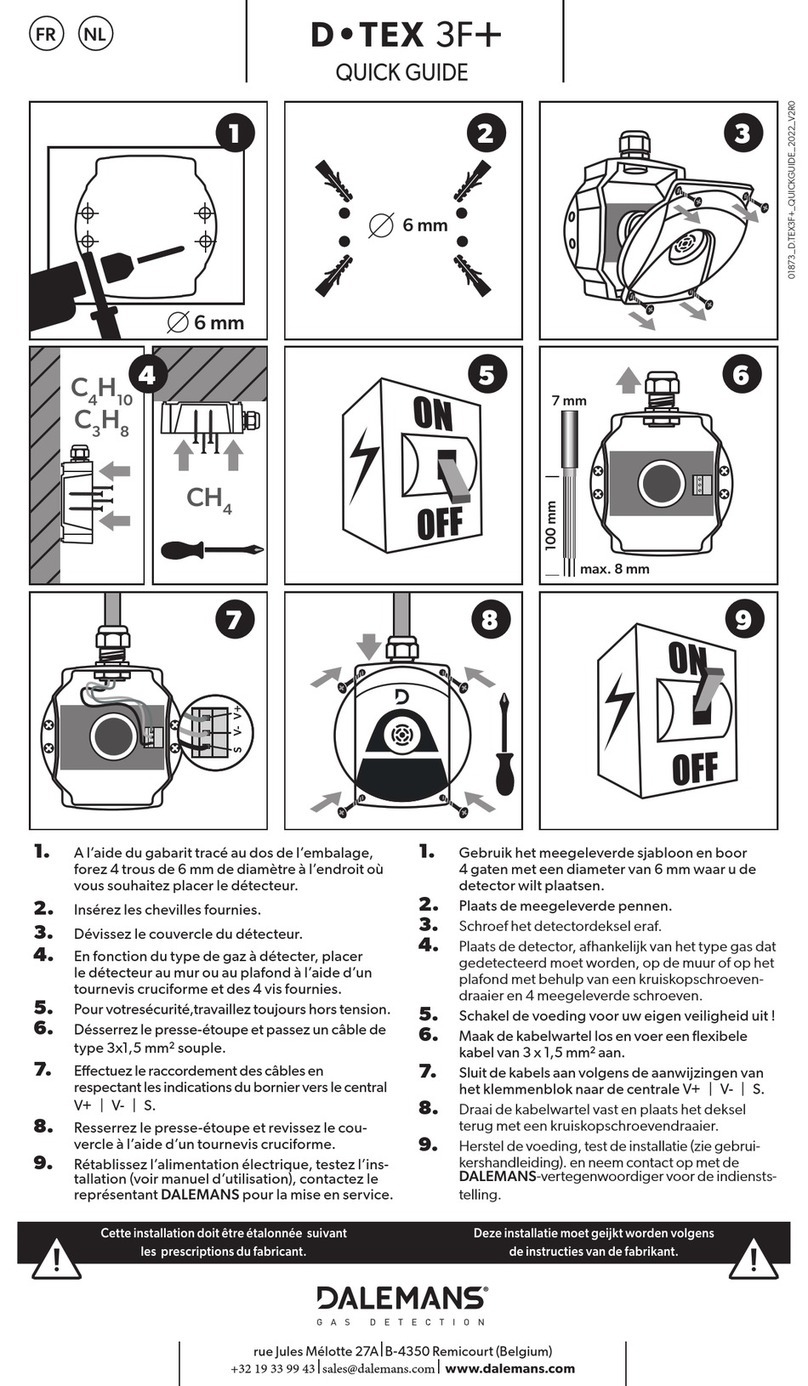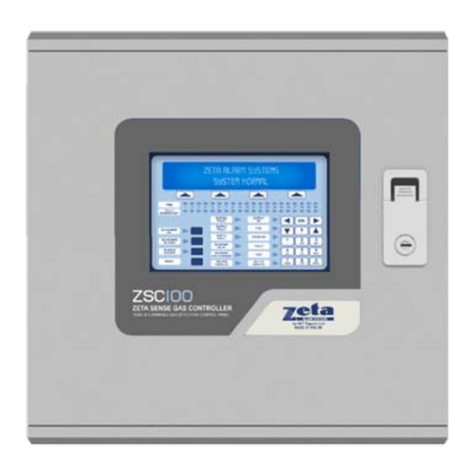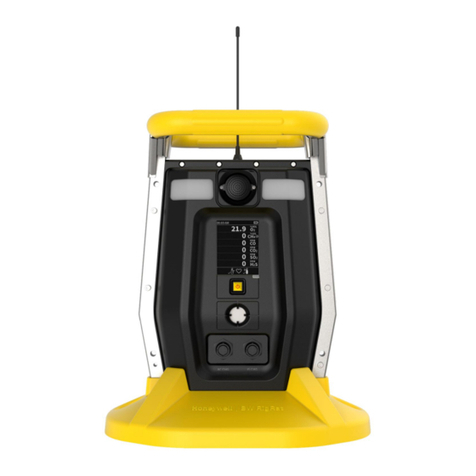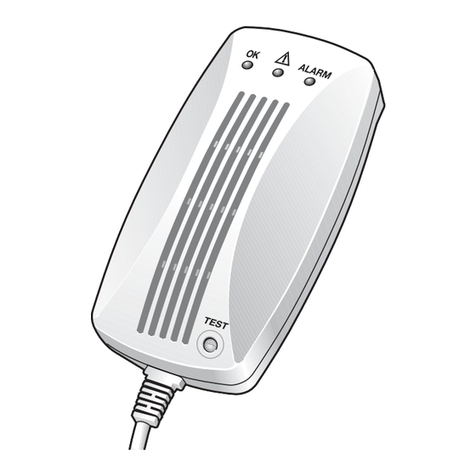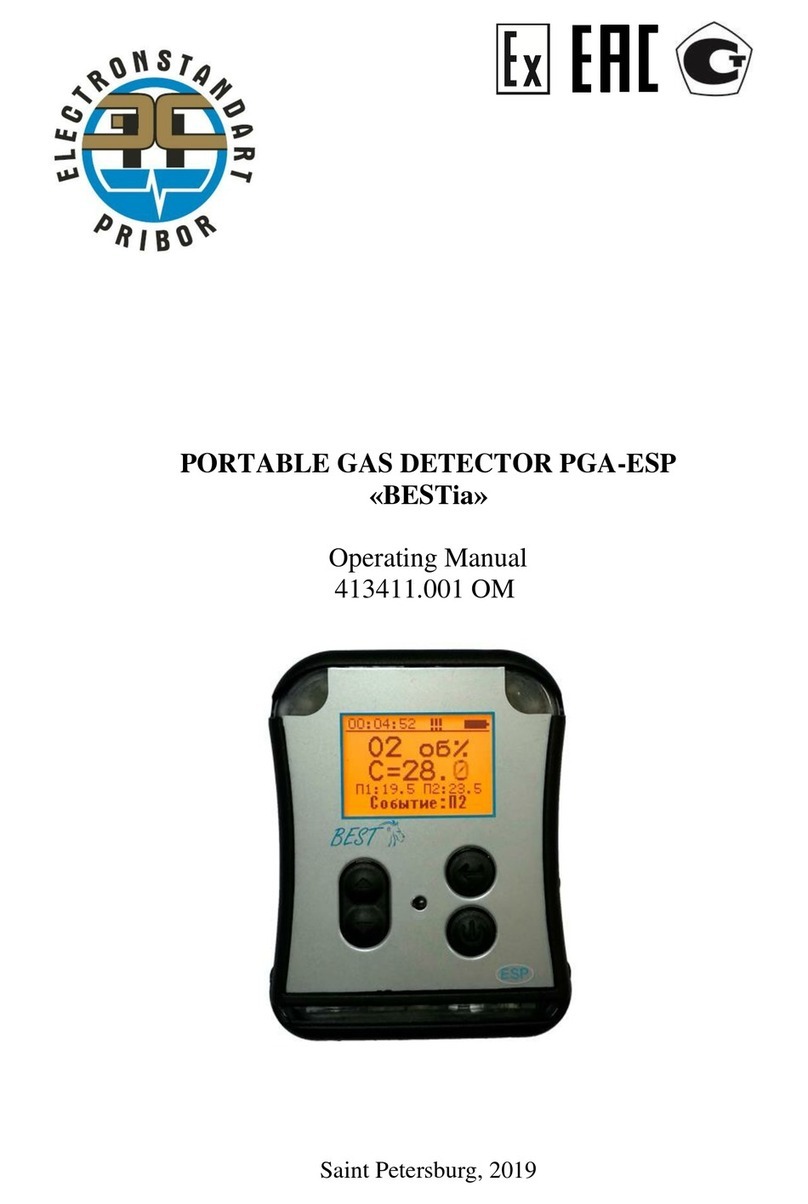New Cosmos Electric NV-100C User manual

1 Point type Combustible Gas Detection /
Alarm System
Model NV-100C
Instruction Manual
●
Keep this instruction manual where itis readily accessible.
●
Thoroughlyread this instruction manualbeforeusing the equipment so it can be used safelyand correctly.
New-Cosmos Electric Co., Ltd.
Instruction manualNo.
GAE-009-01
December 2004

Table of Contents
1. Introduction..........................................................................................................................................................................................
1
2. Safe Operation....................................................................................................................................................................................
1
3. Unpacking............................................................................................................................................................................................
2
4. System Structure.................................................................................................................................................................................
3
5. Dimensions and Part Names ............................................................................................................................................................
4
5-1 Indicator andAlarm Unit...........................................................................................................................................................
4
5-2 Gas Detector .............................................................................................................................................................................
6
6. Installation and Wiring ........................................................................................................................................................................
8
6-1 How to Install the IndicatorandAlarm Unit.............................................................................................................................
8
6-2 How to Install the GasDetector...........................................................................................................................................
10
6-3 Wiring Method.......................................................................................................................................................................
13
7. Operating Instructions ....................................................................................................................................................................
15
7-1 Notes to Users.......................................................................................................................................................................
15
7-2 Procedures............................................................................................................................................................................
15
7-3 Operation of the equipment..................................................................................................................................................
17
7-4 When anAlarm Occurs........................................................................................................................................................
18
7-5 How to replace Batteries (when the equipment has a backup power source)...............................................................
18
7-6 Maintenance Function..........................................................................................................................................................
19
8. Maintenance and Inspections........................................................................................................................................................
26
8-1 Regular Inspections (Inspections that the users are responsible for)..............................................................................
26
8-2 Maintenance inspections (Contact our dealer / agency for the inspection.)....................................................................
27
8-3 Preparation of Calibration Gas – When isobutene 0.72vol%(40%LEL)..........................................................................
28
8-4 Replacing the Gas Sensor...................................................................................................................................................
30
8-5 Replacing the Filter (suction type gas detector).................................................................................................................
32
8-6 Cleaning the Gap Plate (suction type gas detector PE-2DC)...........................................................................................
33
9. Troubleshooting ..............................................................................................................................................................................
34
10. Specifications...................................................................................................................................................................................
35
10-1 Indicator andAlarm Unit.......................................................................................................................................................
35
10-2 Gas Detector .........................................................................................................................................................................
36
11. Consumable Parts and Spare Parts.............................................................................................................................................
36
12. Warranty..........................................................................................................................................................................................
36
13. Service Life......................................................................................................................................................................................
36
14. Glossary...........................................................................................................................................................................................
37

-
1
-
1. Introduction
Thank you for purchasing a NV-100C single-point combustible gas detection /alarm system.
This system is used to prevent leakage of combustible gas. This equipment continuously monitors for leakage of
combustible gas, and indicates when a preset level has been exceeded by a lamp and sound.
Thoroughly read this instruction manual before using the equipment so it can be used correctly. Read the instruction
manual of the gas detector as well.
Symbols
The following symbols are used for safety purposes:
: Indicates an imminently hazardous situation which, if not avoided, will result in death or serious
injury
: Indicates a potentially hazardous situation which, if not avoided, will result in death or serious
injury
: Indicates a potentially hazardous situation which, if not avoided, may result in minor injury or
moderate injury. It may also be used to alert against unsafe practices.
: Operational advice and or instruction.
2. Safe Operation
Carefully read the following so you can use the equipment correctly.
Read and understand all applicable laws and regulations and ensure that you are in complete compliance with
the said laws and regulation before installing or operating the equipment.
Installing, wiring, and other works concerning the equipment should be carried out by qualified persons, following all
applicable federal, state, and local health and safety laws and regulations including OSHA.
WARNING
MEMO
CAUTION
DANGER
Operation checks using actual gas are very dangerous because combustible gas may explode and toxic gas is
harmful. An inspection must be carried out beforehand by persons with sufficient expertise or our service staff.
DANGER
Ground the equipment in order to prevent electric shocks.
In case of an alarm, carry out your predetermined measures for gas leakage.
This equipment is not explosion-proof. Install it in a non-hazardous location.
WARNING
Do not dissemble, alter the equipment, or change its structure and electric circuit. It may affect the
performance of the equipment.
If you control the interlock of external equipment etc. with equipment’s output signal, we are not responsible
for any injuries or damages caused by it.
The equipment is not waterproof. Install it in a place where it willnot get wet.
Follow all related laws and regulations when using the equipment.
Do not use any equipment that generates electrical noises such as cellular phones or radio-communications
within 30 cm of the alarm panel.
CAUTION

-
2
-
3. Unpacking
The following standard components are packed together with the Gas Detector/alarm. Carefully check the contents
against the list when unpacking. If any components are missing or damaged, contact our dealer / agency.
NV-100C main body 1
Gas detector head 1
Without a backup power source 1Fuse 1A With a backup power source 2
For Diffusion type gas detector head 2,3,4mm 1 ea.Lshaped-
wrench For Suction type gas detector head 2,4,5,8mm 1 ea.
Parts to embed the panel (embedded panel only) 1
Air filter FC-32 with flow checker (for Suction type gas detector head only) 1
Sample gas collector PE-N3(for Suction type gas detector head only) 1
NV-100C instruction manual(this book) 1
Test results of the equipment 1
Options (separately sold)
KW-15 for Diffusion type gas detector head KD-5
□
-N 1
Rainproof
cover PW-51 for Suction type gas detector head PE-2DC 1
Rainproof cap KW-22 for KD-5 1
Auto drain AD-40 1

-
3
-
4. System Structure
This equipment consists of a part that detects gas (gas detector head) and a part that indicates gas concentration and sets
off an alarm (indicator and alarm unit). The parts are connected by cables.
Fig. 1 System Structure
The indicator and alarm unit is not an explosion-proof construction. Install it in a non-hazardous area.
CAUTION
One gas detector (either diffusion or suction type gas detector) can be connected. Use a rainproof cover
(option) if you install the equipment outdoor.
The number of cores of cables differs according to the gas detector head connected.
MEMO
Indicator
and alarm
unit NV-
100C
Suction type
gas detector
PE-2DC
Diffusion type
gas detector
KD-5
□
-N
Control
device
Power source
AC100/240V
(DC24V)
A
larm
contact
3C cable
6C cable

-
4
-
5. Dimensions and Part Names
5-1 Indicator and Alarm Unit
Fig. 2 Dimensionsof the Indicator andAlarm Unit (without a backup power source)
Fig. 3 Dimensionsof the Indicator andAlarm Unit (witha backup power source)
1
2
RESET
BZSTOP
POWER
ALARM BACKUP
HGFESRPAPB
5
0
TAZB2ZA2ZB1ZA1COMNARAS TB BZ
15
2
9
10
3
11
5
4
26
27
12
6
8
28
1
14
13
7
29
18 19 20 21 23 22
2‑φ6
24 25
113 71.5
17
16
CD
A.SET
0
6
4
2
10
8
1
2
RESET
BZSTOP
POWER
ALARM BACKUP
HGFESRPAPB
5
0
TAZB2ZA2ZB1ZA1COMN
AR
AS TB BZ
FUSE
30
31
32
3‑φ6
70
110
CD
A.SET
0
6
4
2
10
8

-
5
-
No. Name Function
1 Gas concentration indicator This LCD bar graph meter with backlight indicates gas concentration and the
preset alarm value. The peak value continues to blink even after the reading
value goes down after an alarm.
2 Power lamp (POWER) It is green during normal operation and orange when the sensor failure. It
blinks green when the equipment is turned on and also after a failure has been
taken care of to show that the equipment is warming up.
3 Alarm lamp (ALARM) Ared lamp blinks to indicate a gas leakage and lights up when the buzzer stops.
4Buzzer stop key
(BZ STOP) When this key is pressed, the alarm sound stops and the blinking Alarm lamp
lights up.
5 Reset key (RESET) When this key is pressed after the buzzer stops and reading lowers, the Alarm
lamp and peak hold go off. They do not go off when the key is pressed before
the buzzer stops.
6 Alarm setting key (
△▽
)Use these keys to change the preset alarm value. Press
△
to increase the
set value and press
▽
to decrease it.
7 Backup lamp (BACKUP) It is off in normal state and it blinks red during a power failure. (Equipment with
an optional backup power sources only.)
8 Message window Displays messages during operation of functions.
9 Mode switch Use to set mode such as maintenance mode 1, 2, etc.
10 Function switch Use to set functions.
11 Enter key Use to set functions.
12 SOUND volume control To control alarm buzzer volume. Adjust it when you want to lower the sound.
13 Program connector Use to write in the program. Usually, it is not used.
14 Program switch Use to write in the program. Usually, select the left side.
15 Power switch Aswitch to open/close the equipment’s power source.
16 AC power source fuse
φ
5.2 × 20L 1Aglass fuse.
17 Jumper pin It is used for various settings. No setting by customer is necessary.
18 Sensor signal check terminal
(SIGNAL) Aterminal to check gas sensor signals
19 Sensor current check terminal
(CURR CHECK) Aterminal to check gas sensor current. It can be checked by Tester’s voltage
check range due to its built in 1
Ω
resistance.
20 Battery test key
(B.TEST) To test the battery’s life. This key cannot be used if the equipment does not
have a backup power source.
21 Sensor current
adjustment control (CURR) Avolume to adjust thegas sensor current.
22 Test button (TEST) Use this button for performance tests.
23 Test control (TEST) A control to adjust what the indicator indicates when the Test button is pressed.
It is adjusted so the full scale is indicated.
24 Zero adjustment volume (ZERO) A control to adjust the gas sensor’s zero point. Adjust this in maintenance
mode 2.
25 Span adjustment volume (SPAN) A control to calibrate the indicated value of gas concentration. Adjust this in
maintenance mode 2.
26 Analog output adjustment
volume (L) Acontrol to adjust analog output 4 mA(1V)
27 Analog output adjustment
volume (H) Acontrol to adjust analog output 20 mA(5V)
28 Terminal block Aterminal block to connect external wirings
29 Speaker To sound an alarm
30 Backup power source unit Supplies power from built-in battery in the event of a power failure.
31 Battery switch Aswitch to open/close the battery of the optional backup power source.
32 Battery fuse
φ
5.2 × 20L1Aglass fuse

-
6
-
5-2 Gas Detector
(1) Diffusion type gas detector head KD-5
□
-N
15 Rainproof cover 1 KW
−
15
14 Rainproof cap 1 KW
−
22
13 Screw 1
12 Ground cover
1
11 Ground 1
10 Pan-head screw
2
9 Saddle 1
8 Stand 1
7
M5phexagon socket head bolt
3
6
M4phexagon socket head bolt
1
5 Guard mount 1
4 Sensor guard 1
3 Sensor unit 1
2 Terminalbox cover
1
1 Terminal box
1
# Descriptions Q’ty Remark
Fig.4 Diffusion type gas detector head (KD-5 -N)
Refer to the instruction manual for KD-2A,KD-3Awhen use gas detector head KD-2A
、
KD-3A
MEMO
2
1
8
5
4
3
9
15
6
14
94
67
78
10 13 12
11
7
9942 53 46
2‑9×15
oval hole

-
7
-
(2) Suction type gas detector head PE-2DC
10 Name plate 1
9 1
8 Terminal block 1
7 Suction pump
2
6 Sensor element
1
5 Mount 1
4 Half joint 2
3 Gap plate 2
2 Terminal box
2
1 Detector main body
1
# Descriptions Q’ty Remark
Fig.5 Suction type gas detector head
G
3
/
4
1
122
146
Grounding
terminal
P
A
A
B
4‑ 7
177
137
348
①
⑦
④
③
⑥
⑤
⑩
②
⑧
135
96
7620
34
49

-
8
-
6. Installation and Wiring
6-1 How to Install the Indicator and Alarm Unit
The equipment can be hang on the wall or embedded.
(1) How toinstall on the wall
①
Make holes on the wall as shown in Fig. 6
②
If the equipment has a backup power source, attach two mounting plates on the top and bottom of the
equipment.
③
Align the anchors with the holes then insert a bolt in the upper hole.
④
Insert it in the hole on top of the equipment, insert the other bolt in the bottom hole, then tighten both bolts.
The indicator and alarm unit is not an explosion-proof construction. Install it in a non-hazardous area.
WARNING
The indicator and alarm unit must be installed in a place where someone is always present and is easy to
read so that taking countermeasures and notifying others in case of an alarm is possible.
Do not place the indicator and alarm unit in a place with vibration, electric noise, or corrosive gas. Avoid
places with a high temperature or humidity as well.
CAUTION
As to the gas detector to be connected, refer to its instruction manual.
MEMO
Size of mounting holes is different if the equipment has a backup power source.
If the equipment has no backup power source, a cable can be connected from the back and bottom of the
equipment. If the equipmenthas a backup power source, a cable can be connected only from the bottom.
Leave a 30 cm space under the equipment’s body for maintenance work. If the equipment has a backup
power source, also leave a 30 cm space on the right side of the equipment for changing batteries.
MEMO
Fig. 6 Dimensionsfor Hanging the Equipment on the Wall
With a backup power sourceWithout a backup power source
(Cable inlet)
2-
φ
30
3-
φ
7
3-
φ
7
2-
φ
7113 113
60 70
8.5
172
204
220
234

-
9
-
(2) How to embed on a panel
①
Cut out a rectangular opening in the panel as shown in Fig. 7.
②
Insert the equipment into the opening from front.
Attach the backplate on back of the equipment using the attaching screws as shown in Fig. 8. Then, fasten it
to the panel with fixing screws. The equipment can be attached to a 1.6 to 6 mm thick panel.
Fig. 7 Dimensions to Cut a Panel
Fig.8 Embedding on a Panel
Leave a 30 cm space under the equipment’s body for maintenance work. If the equipment has a backup
power source, also leave a 30 cm space on the right side of the equipment for changing batteries.
MEMO
110
200
Attaching screw
Equipment Equipment
Without a backup power source With a backup power source
Backplate
Panel Panel
Backplate
Attaching screw
Fixing screw Fixing screw

-
10
-
6-2 How to Install the Gas Detector
(1) Suction type gas detector
Use Suction type gas detector head in a location where is hard to access for maintenances such as inside a Pit or
Duct as well as a location where the gas detector head could be watered.
Installation
The gas detector must be handled with care to avoid damaging the explosion proof construction.
Do not install the Gas detector in locations listed below:
-Location where the ambient temperature may drop lower than –10
℃
or exceed 40
℃
.
-Location where dew condensation may occur.
-Location where it could be exposed to direct water.
-Location where corrosive gases may exist.
-Location where get sunshine directly.
-Location where the ambient temperature could change drastically.
-Location where nearby a source of electrical noises.(high frequency, magnetic noises)
Do not install the Gas detector in an atmosphere contaminated with silicon compounds, as silicon could
poison and/or impair the sensitivity of the sensor.
The gas detector should be installed in a location free from vibration.
Avoid severe shocks and /or mechanical impact to the gas detector.
When the gas detector is to be installed in an outside location, make sure to use a rain protective cover or
cap.
Use Auto drain function (optional item) when use the Suction type detector in a location where the detector
could be watered.
The height of the installation of the detector head is an important factor and related to the gas to be
detected, refer to table below.
Kind of gas Installation height Remarks
Gases heavier than air ,such as
LPG About 10cm above the
floor level For maintenance purpose allow at
least 7cm space from floor level
Gases lighter than air, such as
H2,CH4,town gas, natural gas. Near the ceiling Select a location where maintenance
can be easily conducted.
CAUTION
Fig.9 Diffusion type gas detector head
Areas where gases tend to reside
Detector heads
Roof fan
Airintake
Window
(Sideview)
(Plainview)
Detector head tobe installed

-
11
-
・
How to install the fixing plates
Put the gas detector head between the fixing plates (Saddle and Stand) and tighten the pan-head screw to fix.
How to installthe rainproof cover (optional item) and rainproof cap(optional item)
Fig.10 How to install the fixing plate
Fig.11 KW-15 KW-22 installation
Fix on the wall with attachedthe M6
hexagon bolt and the nut.
Tighten the screwto fix
Rainproof cover
(
KW-15
)
Rainproof cap(KW-22)
Fixing plate (saddle)
Fixing plate (stand)
Pan-head screw

-
12
-
(2) Suction type gas detector head
Suction type gas detector should be used in locations as follows.
①
Inside a piping pit or location where is shut tightly.
②
Furnace sampling
③
Location where the ambient temperature is high or low
④
Location where is high
Use 6
φ
×4
φ
pipe work for the Suction type gas detector head and the length should be 30m or less.
And the gas detector head should be installed in a location where is easy to access for maintenance.
Example : locations to install
Installation for Rainproof cover(PW-51)
Fig.12 Example - location to install Suction typegas detector head
Fig. 13 Example - installation for PW-51
Gas collecting pump should be installed at high location where is free from sucking water.
CAUTION
Drainpit A location where is not easy to
access for maintenances.
Rainproof cover
(PW-51)
Gap plate
Gas collector
(PF-N3)
SamplingTube
Filter with Flow
checker(FC-32)

-
13
-
6-3 Wiring Method
Refer the gas detector’s instruction manual as well.
(1) Wiring of power source
Prepare a circuit breaker to connect the power source to the indicator and alarm unit.
(2) Connecting to the gas detector
Use a cable such as 600V vinyl insulated power line(IV),VCTor CVV(0.75-2mm
2
).The wiring length should be as
follows.
0.75mm
2
cable: within 200m
1.25mm
2
cable: within 600m
2.00mm
2
cable: within 1Km
(3) Connecting the external alarm contact
First alarm contact 1c dry contact (AC100V 2Aload resistance) COM
ZA1
ZB1
Second alarm contact 1c dry contact (AC100V 2Aload resistance) COM
ZA2
ZB2
Trouble alarm contact 1c dry contact (AC100V 2Aload resistance) COM
TA
TB
Buzzer contact 1a dry contact (AC100V 2Aload resistance) COM
BZ
Terminal for external alarm stop (AS) and external reset (AR) AS
AR
N
Alarm can be stopped or reset externally by connecting an external switch.
(4) Connecting the analog output terminal
Gas concentration around the gas detector can be continuously monitored and recorded by connecting a
recorder to the analog output terminal. There are G(+) and H(-) terminals on the terminal block. Standard
output is 4-20 mA. Input resistance of the recorder should be 500
Ω
or less.
Turn OFF the indicator and alarm unit’s power before opening the cover of the gas detector. Opening the
cover when the power is on may cause a fire.
Ground the equipment’s main body and gas detector.
WARNING
Make sure that terminal codes of the indicator and alarm unit side and gas detector side are correct.
Use shielded cables and wire them separated from the power line as much as possible.
Concerning the external wiring work for intrinsically safe explosion proof , refer to “Safety Guidelines for
Plants’Electric Equipment.”
CAUTION
Use the external alarm contact only for external alarm equipment and alarm indicators.
Make sure that load current and voltage do not exceed the contact’s capacity.
If you control interlock, etc. using this equipment’s external alarm contact, we are not responsible for any
injuries or damages caused by it.
CAUTION

-
14
-
Fig. 14 Circuit (Diffusion type gas detector head)
Fig.15 Circuit(Suctiontype gas detector head)
COMN
ARAS ZA1 ZB1 ZA2 ZB2 TA TB BZ
ABCDFGHEPAPB
R(P) S(N)
制御機器外部スイッチ
空
上段端子台
下段端子台
+−
アナログ出力
4〜20mA
遮断器
(+) (−)
AC100/200V
(DC24V)
接地
(1〜5V)
D
PA PB A B C
吸引式ガス検知部
PE‑2DC
接地
E
6Cケーブル
External switch Control device
Upper terminal block
Lowerterminalblock
Analog output
4-20mA(1-5V)
Grounding
Grounding
6C cable
SuctiontypePE-2DC
Breaker
COMN
ARAS ZA1 ZB1 ZA2 ZB2 TA TB BZ
ABCDFGHEPAPB
R(P) S(N)
制御機器外部スイッチ
空
上段端子台
下段端子台
B+−
アナログ出力
4〜20mA
遮断器
(+) (−)
AC100/200V
(DC24V)
接地
(1〜5V)
拡散式ガス検知部
接地
E
CA
3Cケーブル
KD‑5□‑N
External switch Control device
3C cable
Breaker
Grounding Diffusion type KD-5
□
-N
Grounding
Analog output
4-20mA(1-5V)
Upper terminal block
Lowerterminalblock

-
15
-
7. Operating Instructions
7-1 Notes to Users
7-2 Procedures
(1) Turning ON the power
①
Turn ON the Power switch. If the equipment has a backup power source, turn ON the Battery switch as well.
②
Gas concentration indicator displays gas concentration and first and second preset alarm values. The Power
lamp blinks green to show that the equipment is warming up.
③
The Power lamp stops blinking and lights up green and normal operation starts. Warming up takes about
thirty seconds.
(2) Gas sensor signal confirmation
①
Connect Tester to a gas sensor current signal terminal and measure the terminal voltage.
②
A terminal to check gas sensor current has its built in 1
Ω
resistance(for example, it measures 150mA when a
terminal voltage is 0.15V).
③
Since gas sensor current varies depending on sensors, always check it with test certificate supplied.
④
Gas sensor current are adjusted at the factory and do not need adjusting at work sites. However if necessary,
adjust it by turning the gas sensor adjustment volume (CURR)
(3) Zero adjustment
1) Correction by the auto zero function
The reading is automatically corrected to zero by pressing the button. Use this adjustment daily for minor
zero point corrections. Refer to 7-6 (1).
2)Analog zero adjustment
Adjust zero by turning the zero adjustment volume. Use this method for most zero adjustments. Refer to
7-6 (2).
3) Zero suppression mode
The indicator sometimes flickers when indication jumps one dot or so because of a small amount of gas
around the gas detector. In this event, turn ON Function Switch 4 to select zero suppression mode and
eliminate flickering of the indicated value. Refer to 7-3 (6).
Make sure that all parts are correctly connected before turning on the power. Check that the terminals of
the gas detector and indicator and alarm unit are correctly connected.
Do not connect a load to the external alarm contact that exceeds the rated capacity.
CAUTION
Make sure that there is no gas around the gas detector before carrying out zero adjustment. If zero
adjustment is carried out when there is gas around the gas detector, the indicator cannot indicate correct
values.
Carry out analog adjustment for trial run or after replacement of thegas sensor.
CAUTION

-
16
-
(4) Setting alarms
Alarm value is set as you specified at the time of delivery. If you want to change it, follow the procedures below.
①
Confirm that it is under the normal mode (Mode Switch 0) then press the Enter key.
②
Message window displays AP 1. Use theAlarm Setting keys (
△▽
) to change the first preset value.
③
Press the Enter key and the message window displays AP 2. Use the Alarm Setting keys (
△▽
) to change
the second preset value.
④
Press the Enter key again to complete the change of preset alarm value. Message window disappears and
normal operation starts.
(5) Buzzer volume
1)Adjusting the buzzer volume
Turning down the SOUND volume control can lower buzzer volume. The sound is set at max at the time of
delivery.
(6) Equipment with a backup power source
The equipment with a backup power source has a function to check the battery’s life. Follow the procedures
below to check the battery’s life.
①
Confirm that normal mode (Mode Switch 0) is selected then press the Battery Test Switch down for five
seconds. The Backup lamp blinks red and message window indicates the battery voltage.
(7) Checking analog output
Terminal block G and H can output 4-20 mA(1-5V).
①
Connect a tester to terminal block G and H. Adjust the indicated value at zero using the Test control while
pressing down the Test button. Check output on the tester. You do not need to adjust if it reads 4 mA (1V).
If it is off, adjust by turningAnalog Output Adjustment control (L).
②
Adjust the indicated value at full scale using the Test control while pressing down the Test button. Check
output on the tester. You do not need to adjust if it reads 20 mA (5V). If it is off, adjust by turning Analog
OutputAdjustment volume (H).
③
Repeat procedures 1 and 2 several times until 4-20 mA(1-5V) is read.
Keep the sound at max unless there is a particular reason for lowering it
CAUTION
The equipment has a function to check the battery’s life. Use this function during monthly inspections, etc.
Battery test is only a simple test. To find out the battery’s actual life, turn OFF the Power switch and carry
out a discharge test.
Replace battery every three years.
The Battery Test key cannot be used in maintenance mode 1 and 2. Use the key in normal mode.
MEMO
POWER
ALARM
2
1
RESET
BZSTOP
BACKUP
A
P 2
Change the
second
preset
alarm value
POWER
ALARM
2
1
RESET
BZSTOP
BACKUP
A
P 1
Change the
first preset
alarm value

-
17
-
7-3 Operation of the equipment
(1) When gas is detected
When gas concentration around the gas detector becomes high and the reading of the gas concentration
indicating bar graph exceeds the first preset alarm value, the first Alarm lamp blinks and an alarm sound (four
short beeps) is heard. When the reading exceeds the second preset alarm value, the second Alarm lamp blinks.
At the same time, the peak hold value blinks on the indicator.
(2) When the Buzzer Stop (BZ STOP) key is pressed
An alarm sound stops and the blinking Alarm lamp on the indicator unit lights up. Peak hold is still indicated in
this state.
When using an external alarm stop terminal, you can stop the buzzer using an external switch.
(3) When the Reset key is pressed
When the Reset key is pressed after the buzzer is stopped and the reading lowers to below the preset alarm
value, theAlarm lamp and peak hold go off.
When using an external reset terminal, you can reset using an external switch.
(4) In case of a failure
1) When the gas detector is out of order
The Power lamp lights up orange, an alarm sound (four short beeps) is heard, and message window displays
the type of the failure.
(Failure E: Sensor failure, H: Sensor heater wire failure, F: Flow decline)
2) When the Buzzer Stop (BZ STOP) key is pressed.
When the BZ STOP key is pressed, the alarm sound stops.
3)After the failure has been fixed
The Power lamp changes from orange to blinking green and the equipment goes into warming up state.
After warming up, it returns to its normal state.
(5) Equipment with a backup power source
1) In case of a power failure
Intermittent monitoring : The Backup lamp blinks red and battery starts supplying power to the equipment. It
continues monitoring gas leakage for 30 minutes,then it monitors intermittently. During the intermittent
monitoring mode, the Backup lamp blinks red and Power supply lamp and gas concentration indicator are
turned off.
Continuous monitoring :The Backup lamp blinks red and battery starts supplying power to the equipment so
that it can continue monitoring gas leakage.
2) When battery voltage lowers below the final voltage
The battery automatically stops discharging power and the equipment stops entirely.
3) When power is recovered
The Backup lamp goes off and the equipment returns to its normal operation. When power is recovered after
the equipment stops because of over discharge, the equipment starts operating from warming up state.
Reset does not work by pressing the Reset key before operating the BZ STOP key.
MEMO

-
18
-
(6) Function switches
The equipment’s Function switches (No. 10 on Fig. Dimensions of the Indicator andAlarm Unit in 5-1)
Function switch no. Function OFF ON
1 Alarm sound N/A Always ON
2 Alarm sound ON/OFF ON OFF
3 Ten second alarm delay ON/OFF OFF ON
4 Zero suppression function ON/OFF OFF ON
5 Self-retention /Auto-restore Self-retention Auto-restore
6 Trouble alarm : normally open / close Normally open Normally close
7 Heater disconnection alarm ON/OFF ON OFF
8 Flow decline alarm ON/OFF ON OFF
7-4 When anAlarm Occurs
7-5 How to replace Batteries (when the equipment has a backup power source)
①
Detach the battery cover on the right side of the backup power source unit.
②
Detach the battery connector and take out the batteries.
③
Insert new batteries and attach the connector.
④
Put the battery cover back.
If you change setting for function switches, the equipment cannot perform as it is supposed to, for example,
alarm does not go off even when there is gas leakage. Do not change setting unless you completely
understand features of Function switches.
CAUTION
When gas leaks indoors, open windows and doors for better ventilation.
Use our Gas Leak Detector XP-702S to efficiently find where the gas is leaking from.
MEMO
In case of an alarm, carry out your predetermined measures for gas leakage.
WARNING
Replace two batteries at the same time.
Do not catch the harness when attaching the battery cover.
CAUTION
Fig. 16 How to replace the Batteries
1
2
RESET
BZSTOP
POWER
ALARM BACK UP
A.SET
0
6
4
2
10
8
1
2
RESET
BZ STOP
POWER
ALARM BACK UP
A.SET
0
6
4
2
10
8
Table of contents
Other New Cosmos Electric Gas Detector manuals
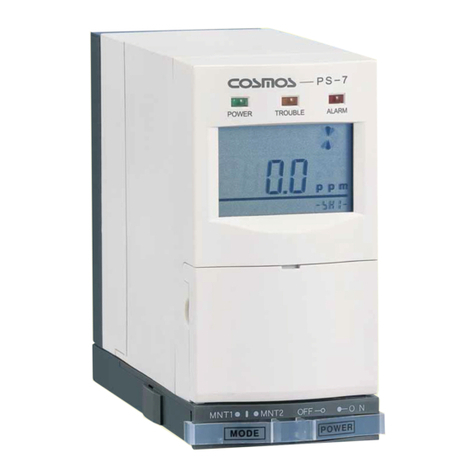
New Cosmos Electric
New Cosmos Electric PS-7 User manual
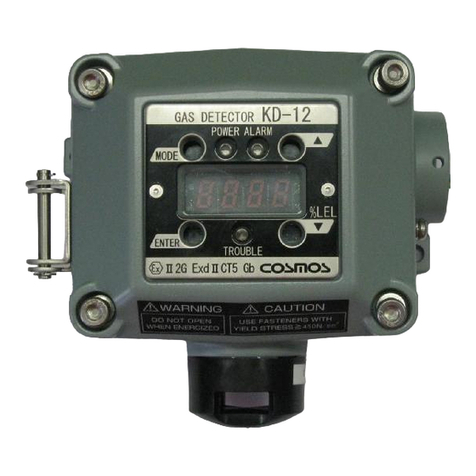
New Cosmos Electric
New Cosmos Electric KD-12B User manual

New Cosmos Electric
New Cosmos Electric PS-7-M Use and care manual
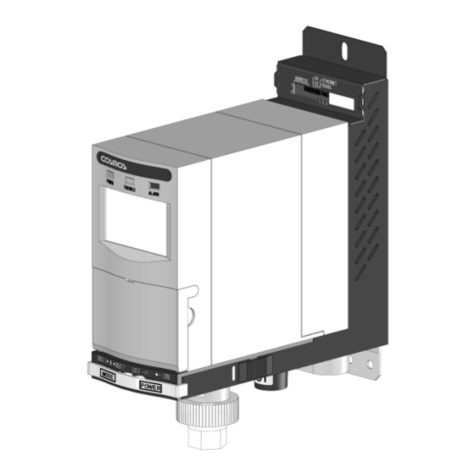
New Cosmos Electric
New Cosmos Electric PS-7-M User manual
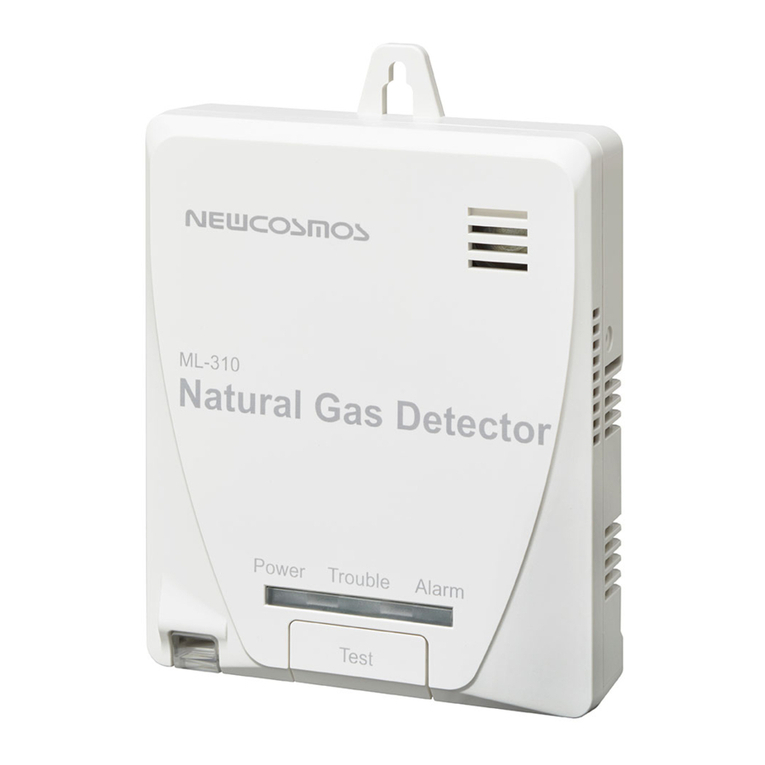
New Cosmos Electric
New Cosmos Electric ML-310 User manual

New Cosmos Electric
New Cosmos Electric NV-100H User manual

New Cosmos Electric
New Cosmos Electric XA-4400II User manual
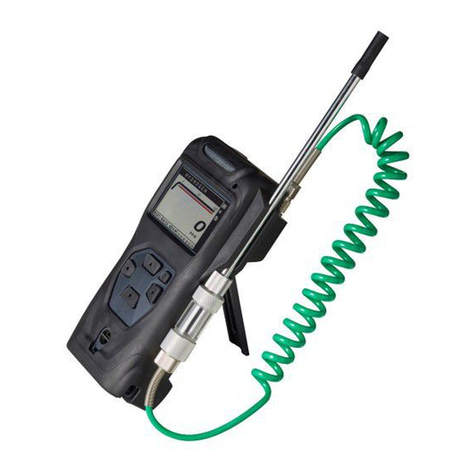
New Cosmos Electric
New Cosmos Electric XP-3000II Series User manual
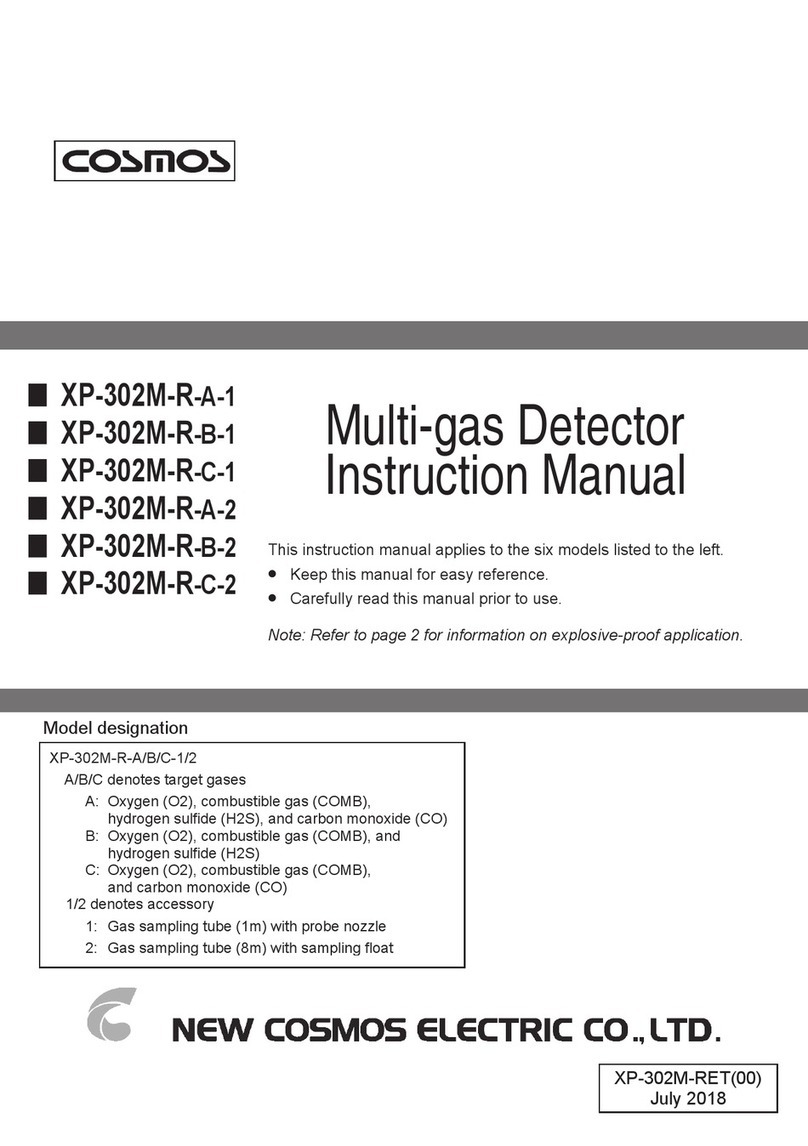
New Cosmos Electric
New Cosmos Electric XP-302M-R-A-1 User manual
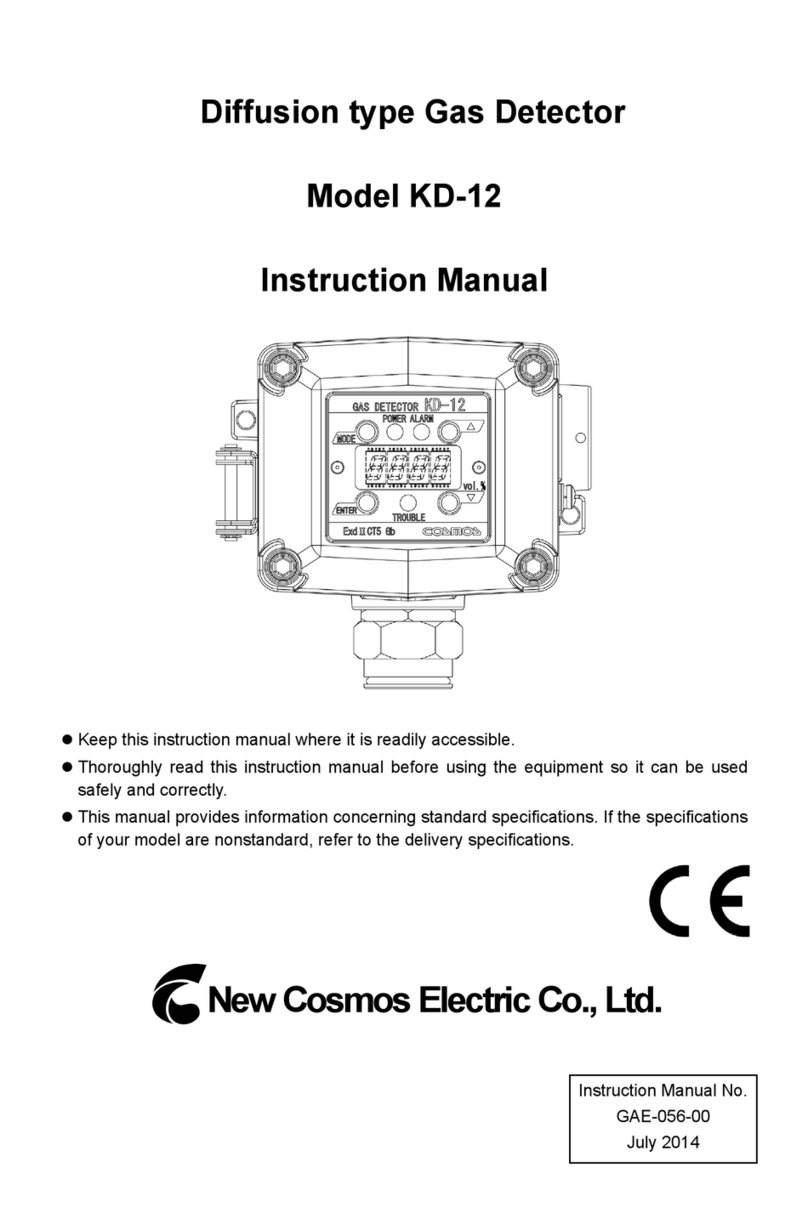
New Cosmos Electric
New Cosmos Electric KD-12 User manual
